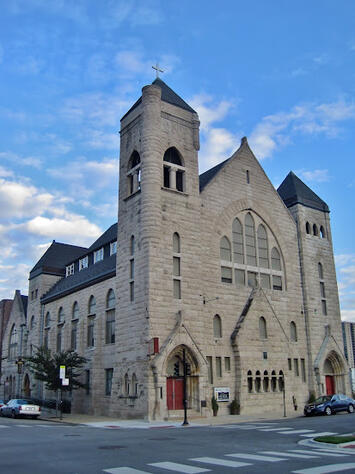
Anyone who’s watched the changes in Chicago’s Near South Side community over the last 30 years can tell you, it’s undergone a complete transformation in a generation’s time. Many observers might look at the Near South Side and think it went from nothing to something over that period. Not true. It was always a community of constant change. My father was one person who anticipated the next transformation and fought valiantly for it to be more inclusive.
In 1987 my father accepted the position as pastor of Quinn Chapel African Methodist Episcopal (AME) Church in Chicago. It’s known as the oldest Black church in Chicago, founded in 1847. He lasted there for ten years, presiding over the church’s celebrated 150th anniversary before moving on to Bethel AME Church in Saginaw, MI. He would pastor there for twenty years before retiring.
When we moved here I had just graduated from Indiana University. We lived in Muncie, IN for seven years as my father pastored his first church there. I looked forward to moving to a city with wider job opportunities. Not much opportunity, however, was apparent in the Near South Side at the time. It was clear the community was a shadow of its former self; the second half of the twentieth century had not been kind to the Near South Side.
Of course, that wasn’t always so. Following the Great Chicago Fire in 1871 the area rapidly grew. By the 1880s the area had become the residence of many of the city’s business and social elite, with beautiful mansions served by wide boulevards leading to the Loop. By the time of the Chicago World’s Fair in 1893, the Near South Side became known as a popular entertainment stop for trains between downtown and the Jackson Park location of the fair. That later grew into Chicago’s red-light district, known as the Levee District, prompting many of the wealthy to move on. Quinn Chapel’s members took a chance on the community, purchasing land at 24th and Wabash and constructing the church in 1891. The 130-year-old building still serves the congregation today.
I don’t know the specifics of why that site was selected, but I can surmise that Quinn’s members saw the site as an affordable option in a constantly changing, somewhat transient community that was adjacent to the growing “Black Belt” or Bronzeville neighborhood further south. They were able to choose this site because of the constant change in the area. Change that continued for decades.
What kind of change? The growth and expansion of warehouses and light manufacturing structures. The development of Chicago’s Motor Row. The construction of the Chicago Park District’s stadium in 1924, later known as Soldier Field. Actually hosting another World’s Fair, the Century of Progress in 1933. Post World War II the change continued – urban renewal land acquisitions for slum clearance, the construction of nearby interstate highways and public housing, and the development of the McCormick Place convention center by 1960.
Change had been the one constant of the Near South Side, until it wasn’t. From its beginnings the community had been the home of working class white ethnics who worked on the construction of the Illinois and Michigan Canal and then in the warehouses and industrial buildings that followed. There was also a significant Black presence in the community, which many Blacks regarded as the gateway to Bronzeville.
The Near South Side never had a very strong residential presence in its first 100 years; the concentration of warehousing and industry probably made sure of that. That also likely made it a target for the development of public housing. The Harold Ickes Homes and Dearborn Homes were constructed by 1955, and were the northern edge of the virtual wall of public housing towers that would stretch southward for almost five miles. The Near South Side reached a population peak of 11,300 in 1950. But population steadily dropped in the ensuing years, bottoming out at 6,800 in 1990.
Read the rest of this piece at Corner Side Yard Blog.
Pete Saunders is a writer and researcher whose work focuses on urbanism and public policy. Pete has been the editor/publisher of the Corner Side Yard, an urbanist blog, since 2012. Pete is also an urban affairs contributor to Forbes Magazine’s online platform. Pete’s writings have been published widely in traditional and internet media outlets, including the feature article in the December 2018 issue of Planning Magazine. Pete has more than twenty years’ experience in planning, economic development, and community development, with stops in the public, private and non-profit sectors. He lives in Chicago.
Photo: Chicago's Quinn Chapel African Methodist Episcopal Church at 24th and Wabash on the Near South Side. The oldest Black church in the city, established in 1847. The current structure was completed in 1891. Source: Flickr, under CC 2.0 License












